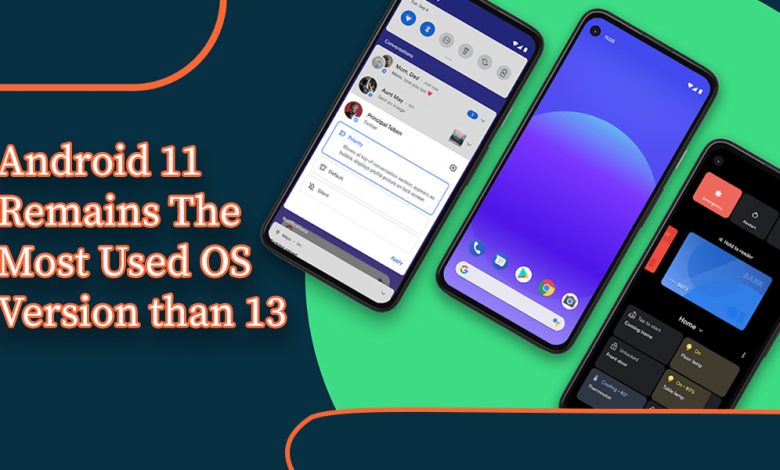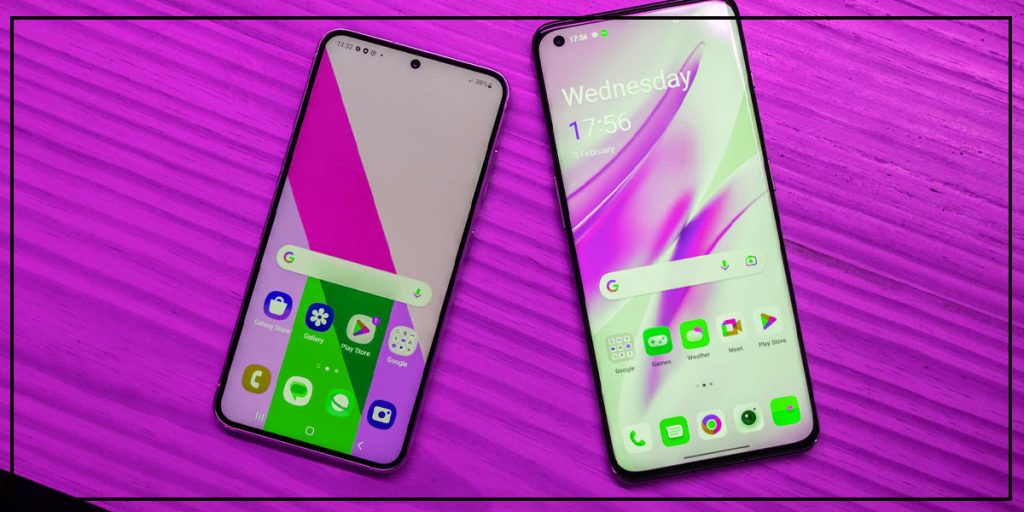Android 11 Remains the Most Used OS Version Than 13

The Android operating system has become a dominant force in mobile devices, powering billions of smartphones and tablets worldwide. With each new version, Android brings new features, optimizations, and improvements to the user experience. Keeping track of the adoption rate and usage statistics of different Android OS versions is crucial for developers, manufacturers, and users.
In this article, we will look closer at the current state of Android OS versions, specifically focusing on Android 11 and 13. We will delve into the importance of OS version statistics and discuss why, despite the introduction of Android 13, android 11 remains the most widely used OS version.
Android 11
Android 11, a major release of the Android operating system, was officially released on September 8, 2020. It brought many new features and updates to enhance user experience, improve privacy and security, and optimize performance. Some key features introduced in Android 11 include a revamped notification system with conversation bubbles, improved media controls, built-in screen recording, enhanced privacy settings, and a more streamlined intelligent home device control panel. Compared to its predecessor, Android 10, android 11 significantly improved user interface, functionality, and performance. The release of the 11th was met with positive response from the Android user community. It quickly gained adoption by various smartphone manufacturers and devices, showcasing its popularity among Android users worldwide.
Android 13
As the latest iteration of the Android operating system, Android 13 has generated significant anticipation and excitement among the Android user community. Released on its official launch date of October 1, 2022, Android 13 brought forth many new features and updates designed to enhance user experience, improve security, and offer cutting-edge capabilities. While the specific features of Android 13 may vary depending on device manufacturers and models, overall enhancements such as improved performance, updated privacy settings, enhanced customization options, and new UI elements have been eagerly anticipated by Android users worldwide. With the launch of Android 13, android enthusiasts and users alike eagerly await the new possibilities and functionalities it brings to their smartphones and tablets.
Comparison of Adoption Rates
- Adoption rates data from various sources indicate that Android 11 has a higher adoption rate than Android 13.
- According to Google’s Android Developer Dashboard, as of September 2021 (knowledge cutoff), it had a global adoption rate of over 30% among active Android devices. In contrast, android 13 was not released at that time.
- Other third-party data sources also show similar trends, with 11 maintaining a higher adoption rate than Android 13.
- Factors contributing to the slower adoption of Android 13 could include device fragmentation, as not all Android devices receive timely updates to the latest OS version. Some devices may not be eligible for the Android 13 upgrade due to hardware limitations or other factors.
- The timing of Android 13, and the data cutoff date for adoption rate statistics, could also be a factor, as newer OS versions typically take time to gain widespread adoption among Android users.
- While Android 13 may eventually catch up in adoption rate, the current data suggests that Android 11 remains the most widely used OS version among Android users.
Reasons for Android 11’s Continued Popularity
Stability and Performance Improvements: It has been widely recognized for its stability and performance improvements compared to previous versions. Users have reported fewer crashes, improved app launch times, and smoother performance, making it a reliable choice for many.
User-friendly Features: Android 11 introduced several user-friendly features such as conversation bubbles, improved media controls, built-in screen recording, and a more streamlined intelligent home device control panel. These features have enhanced the overall user experience and made it a preferred choice for many users who value convenience and ease of use.
Positive User Feedback and Reviews: It has received positive user feedback and reviews, further contributing to its popularity. Users have appreciated the new features, improved performance, and enhanced privacy settings, which have helped build their positive reputation among the community.
Wide Device Support: It has been adopted by a wide range of devices from various manufacturers, providing a wide device support base. This has ensured that many Android users can upgrade to Android 11 and enjoy its benefits, contributing to its continued popularity.
App Compatibility: Its compatibility has also played a role in its continued popularity. Many apps have been optimized and updated to work seamlessly with it, ensuring users can continue using their favorite apps without any issues.
Long-term Support: It has also benefited from long-term support from Google, with regular security updates and bug fixes, ensuring the OS remains stable, secure, and reliable.
Read Also: Oppo A16 Price in Pakistan

Analysis of Usage Statistics
Adoption Rate: Based on available data and statistics, android 11 maintains a higher adoption rate than Android 13. This indicates that a more significant percentage of active Android devices are still running 11, despite the release of 13.
Time Since Release: Android 11 was released before Android 13 and has had more time to gain widespread adoption among Android users. Android 13, being a newer release, may still be in the early stages of adoption, and it may take time to catch up to the adoption rate of the 11th Android.
Device Fragmentation: Android has a wide range of devices from different manufacturers with varying hardware capabilities, and not all devices are eligible for timely updates to the latest OS version. Some older devices may not be compatible with Android 13 due to hardware limitations or other factors, which could impact its adoption rate.
Upgrade Cycle: Android users may not upgrade to the latest OS version immediately for various reasons, such as personal preference, device compatibility, or reluctance to change. Some users may prefer to stick with the familiar interface and features of 11th, which they are already familiar with, rather than upgrading to a newer version like Android 13.
Feedback and Reviews: User feedback and reviews can influence the adoption rate of a new OS version. If Android 11 received positive user feedback and assessments, it could have contributed to its continued popularity and higher adoption rate than Android 13.
App Compatibility: The compatibility of apps with different OS versions could also impact the adoption rate of Android 13. If some apps are not optimized or compatible with Android 13, users may be hesitant to upgrade, as they may face issues with their favorite apps.
Challenges Faced by Android 13
Device Fragmentation: One of the challenges faced by Android 13 could be device fragmentation, as the Android ecosystem consists of a wide range of devices from different manufacturers with varying hardware capabilities. This can delay timely updates to the latest OS version, as not all devices may be eligible or receive updates simultaneously. This can impact the adoption rate of Android 13, as some users may be unable to upgrade due to device limitations or delays in updates from device manufacturers.
Delayed Updates: Another challenge could be delayed updates from device manufacturers. Some device manufacturers may take longer to roll out updates for their devices, resulting in a delay in users being able to upgrade to Android 13. This can affect the adoption rate, as users may have to wait longer for the update to become available on their specific devices.
Compatibility Issues with Older Devices: Compatibility issues with older devices could also be challenging for Android 13. Older devices may struggle to meet the hardware requirements as OS versions advance, resulting in limitations or the inability to upgrade to the latest OS version. This can impact the adoption rate of Android 13, as users with older devices may be unable to upgrade and may have to stick with the previous OS version.
Reported Bugs or Issues: Any reported bugs or issues with Android 13 could also impact its initial adoption rate. If users encounter significant bugs or issues after upgrading to Android 13, it could lead to hesitation among other users to upgrade, as they may want to wait for bug fixes or improvements before adopting the new OS version. This can affect the initial adoption rate of Android 13 and may result in slower adoption compared to previous OS versions.
Conclusion
The analysis of usage statistics and factors influencing adoption rates of Android 11 and Android 13 reveals that 11 remains the most used OS version compared to Android 13. Despite the launch of Android 13, 11 has continued to be popular among Android users due to its stability, performance improvements, and user-friendly features. However, challenges such as device fragmentation, delayed updates from device manufacturers, compatibility issues with older devices, and reported bugs or issues may have impacted the adoption rate of Android 13. This has implications for Android users and developers, highlighting the importance of timely updates, addressing device fragmentation, and resolving reported issues to ensure the smooth adoption of new OS versions. As the Android ecosystem evolves, it will be crucial for Google and device manufacturers to address these challenges and provide a seamless experience for users upgrading to newer OS versions.


